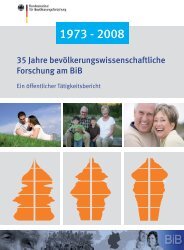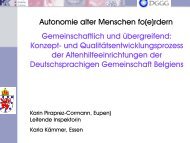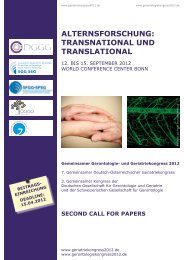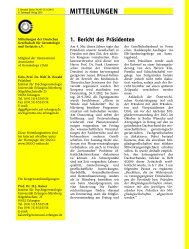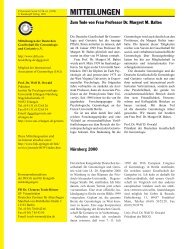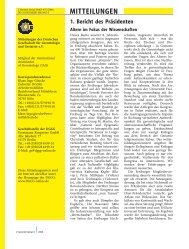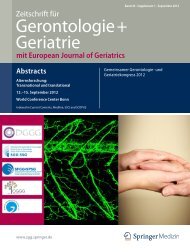G-AEP-Kriterien - Deutsche Gesellschaft für Gerontologie und ...
G-AEP-Kriterien - Deutsche Gesellschaft für Gerontologie und ...
G-AEP-Kriterien - Deutsche Gesellschaft für Gerontologie und ...
Erfolgreiche ePaper selbst erstellen
Machen Sie aus Ihren PDF Publikationen ein blätterbares Flipbook mit unserer einzigartigen Google optimierten e-Paper Software.
which influenced inappropriate hospital use, were identified and modified. The impact of<br />
these modifications was then assessed. Main Outcome Measures. The proportion of<br />
inappropriate hospital admissions and inappropriate hospital days. Results. As a baseline<br />
assessment before quality improvement interventions, the appropriateness of hospital use<br />
(admissions and hospital days) was evaluated using the Appropriateness Evaluation<br />
Protocol (<strong>AEP</strong>) in a sample of 500 patients (5665 days). After modification of the two<br />
processes through a quality improvement program, inappropriate hospital use was<br />
reassessed in a sample of 498 patients (6095 days). Inappropriate hospital admissions<br />
decreased from 15 to 9% (P = 0.002) and inappropriate hospital days from 28 to 25% (P =<br />
0.12). Conclusion. Using the <strong>AEP</strong> as a criterion, the quality improvement interventions<br />
significantly reduced inappropriate hospital use due to the process of non-urgent<br />
admissions, but the reduction of inappropriate hospital days specifically attributed to the<br />
transfer to the rehabilitation hospital did not reach statistical significance.<br />
ET: Public Health, Social Medicine and Epidemiology - 17<br />
Health Policy, Economics and Management - 36<br />
4/26 von 41 DIMDI: EMBASE (EM74) © Elsevier Science B.V. 2002<br />
Titel: Review of the utilisation of a university hospital in Barcelona (Spain): Evolution 1992-<br />
1996<br />
Autoren: Navarro G; Prat-Marin A; Asenjo MA; Menacho A; Trilla A; Salleras LL<br />
Quelle: European Journal of Epidemiology; 17/7 (679-684); 2001<br />
Sprache: ENGLISH<br />
Institution: Dr. A. Prat-Marin, Prog. Calidad Asistencial Dir. Tec., Hospital Clinico Universitario,<br />
Villarroel 170, 08036 Barcelona; Spain; prat@medicina.ub.es<br />
Schlagwörter<br />
CT: HOSPITAL UTILIZATION*; SPAIN; UNIVERSITY HOSPITAL; HOSPITAL ADMISSION;<br />
LOGISTIC REGRESSION ANALYSIS; HOSPITAL DISCHARGE; HOSPITAL<br />
MANAGEMENT; HUMAN; MALE; FEMALE; ADOLESCENT; AGED; CHILD; ADULT;<br />
REVIEW<br />
Sonstige Information<br />
ND: 2002201845<br />
RN: 32<br />
CO: EJEPE<br />
ISSN: 0393-2990<br />
CY: Netherlands<br />
AL: ENGLISH<br />
DT: Journal; Review<br />
AB: Backgro<strong>und</strong>: To test the applicability of the appropriateness evaluation protocol (<strong>AEP</strong>) as<br />
a tool for reviewing hospital utilisation. To quantify and to compare the rate of inappropriate<br />
admissions and amount of in-hospital days, emphasising the main causes and factors in the<br />
hospital associated with inappropriateness during the studied periods of time. Patients and<br />
methods: Two retrospective studies were carried out, the first one in 1992, when 2048<br />
clinical histories were analysed, and the second in 1996, with 1099 reviewed histories. The<br />
tool used for the evaluation of the level of hospital utilisation is the <strong>AEP</strong>. Results: The<br />
proportion of admissions considered to be inappropriate was 25% (95% CI: 20.8-24.5) in<br />
1992, and 16% (95% CI: 13.8-18.2) in 1996. Premature admission was the most frequent<br />
cause of inappropriateness in both periods. The logistic regression model built for the<br />
dependent variable admission showed the following variables to be associated to<br />
inappropriateness: scheduled admission (OR: 15; 95% CI: 10.8-20.7) and (OR: 10; 95% CI:<br />
6-16.5), weekend admission (OR: 2; 95% CI: 1.3-1.2) and (OR: 2; 95% CI: 1.2-2.3), for<br />
1992 and 1996, respectively. The rate of inappropriate in-hospital stays in 1992 was 29%<br />
(95% CI: 28.3-29.6), and 13.5% (95% CI: 12.7-14.3) in 1996. Hospital organisational<br />
problems were the main cause of inappropriate in-hospital days in 1992, and<br />
diagnostic/therapeutical tests that could be performed ambulatorily ranked first in 1996. The<br />
logistic regression model built for the dependent variable in-hospital days had the following<br />
independent variables associated to its inappropriateness: discharge on week-days (OR:<br />
1.4; 95% CI: 1.2-1.8) and (OR: 0.6; 95% CI: 0.5-0.8) and length of stay (OR: 2; 95% CI: 1.8-<br />
2.4) and (OR: 2.4; 95% CI: 2.3-2.5), for 1992 and 1996 respectively, among other variables.<br />
Conclusion: Periodic checking of the utilisation levels with the application of methods such<br />
as the <strong>AEP</strong> will contribute towards adapting hospital management in the more competitive<br />
current setting.<br />
ET: Public Health, Social Medicine and Epidemiology - 17<br />
G-<strong>AEP</strong>_Bericht_703.doc-22.08.2003-51



